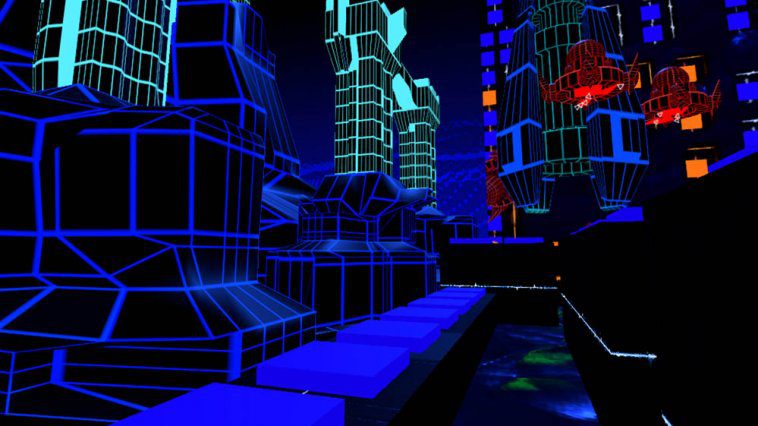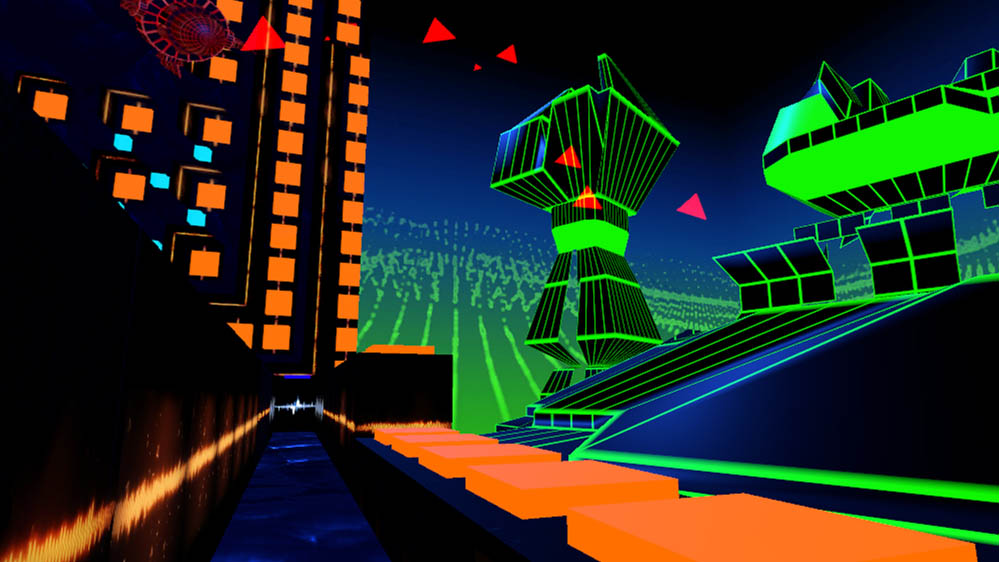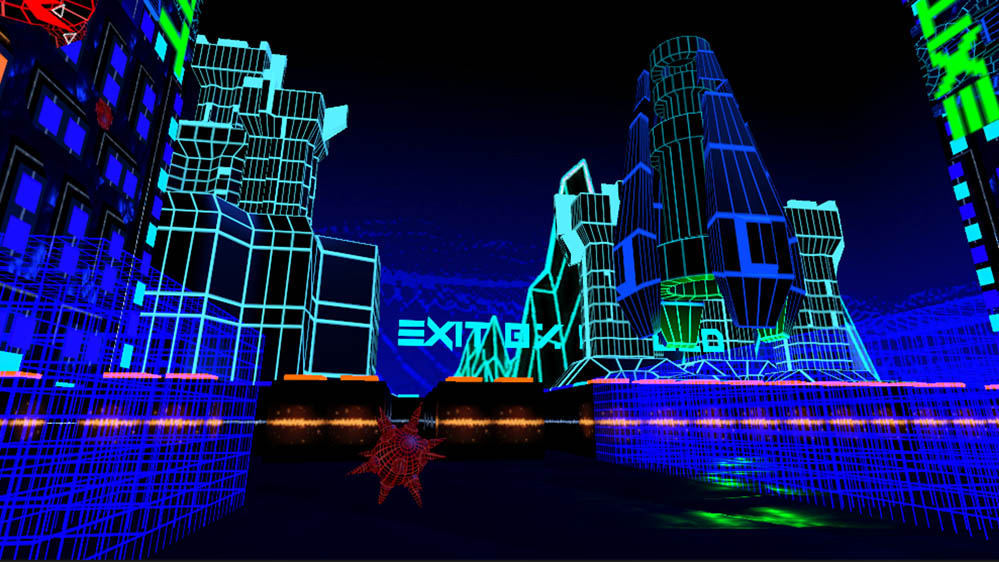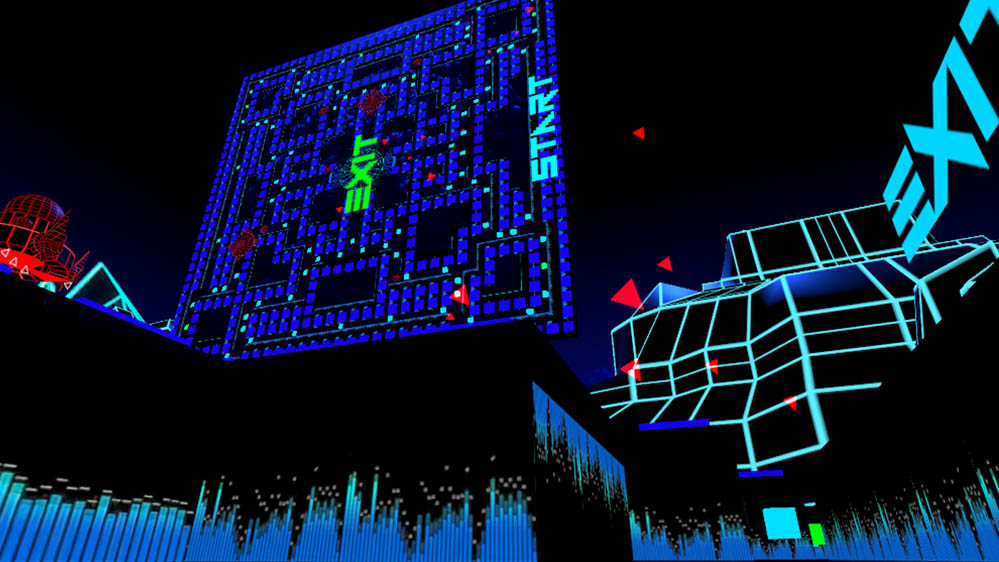One part retro-cyberpunk aesthetic, one part old-school gameplay and all brought together with a great soundtrack: this is GalactaVision’s Trakker. We chatted with Nathan Thorin and Greg Corcoran about their latest project. Questions by Nathan Ortega.
<\\/div> <p><em><strong>Tell us a bit about yourself and the team at GalactaVision.<\\/strong><\\/em><\\/p> <p><strong>Nathan Thorin:<\\/strong> I founded GalactaVision in 2013 after graduating from game design school in Madison, WI. Since then, our small team have created game software specifically built for Virtual Reality. We have continuously promoted VR by demoing and testing it in public throughout the Midwest over the last 5 years.<\\/p> <p>My portfolio includes being a team lead, artist\\/art director and assistant programmer\\/game designer on three of our published VR titles. Our current project is <em>Trakker<\\/em>.<\\/p> <p><strong>Greg Corcoran:<\\/strong> I’m the kind of person who likes making things. My grandfather built a houseboat in his backyard, my father was a designer at Harley-Davidson and now I’m making VR games. It just feels like the right thing to do.<\\/p> <p>I previously worked as a software developer at IBM Watson Health Imaging. My department managed most of the business and we would maintain, extend and integrate with many different systems that the department’s needed to function.<\\/p> <p>Of course, that resulted in working with many different technologies, languages and integrations, all with their own unique quirks. A pretty good grounding for VR development!<\\/p> <p><img class="aligncenter size-full wp-image-10271" src="https:\\/\\/www.blogdot.tv\\/wp-content\\/uploads\\/2018\\/10\\/going-retro-in-vr-with-trakker.jpg" alt="Trakker" width="999" height="562" \\/>\"}';Going retro in VR with Trakker

Trakker is steeped in retro science fiction and computer aesthetics. What were some of your main influences?
Nathan: I’m a total Sci-fi enthusiast. I read William’s Gibson’s Neuromancer in high-school and never turned back from my affinity for the cyberworlds and metaverses. From the Tron movies to the cartoons, Ghost in the Shell‘s depiction of internal digital landscapes to the influence of the future-retro take in modern Synthwave, aesthetic and glitch art movements. I’ve lived, played and worked in cyberspace and arcades for years. This is us having some fun with it and building the game we’ve wanted to play for the last three decades.
We’re attempting to re-invent, drawing from the things we love and combining the old with the new. It’s a gameified soundtrack in a way. It’s a high-score quarter plunker in another. It’s a VR arcade game from an alternate reality of 1997.
Greg: I love the cyber-punk aesthetic and nearly everything that touches on it draws me in. Some of the largest ethical questions we’ll be facing in the next century will be related to technology, but that’s not a theme we’ve involved in the game yet.

Trakker combines gameplay elements that are reminiscent of several distinct eras of retro arcade games. Were there any particular titles that inspired the core concepts of Trakker?
Greg: I spent some time thinking about what has worked well in VR and what hasn’t. One of the design concepts that is pretty nailed down is the wave shooter. Outside of that, it’s less obvious and less consistently well done. I thought trying to get back to the arcade basics would be a good start to seeing how things would play out in VR.
Pac-Man, obviously being one of the more iconic classics, is an inspiration for the game. When you think of games like that you may not have a lot of options as a player, but those options are massively important. Trying to make simple actions feel important is one of the things the classic arcade games did best, and that’s what the aim was from the start for Trakker.
Trakker uses a very clear way of handling navigation, having players shake their Vive controllers as if they are taking each step to frantically run around the labyrinth. What inspired that?
Greg: There have been other games that have worked with the arm swinging mechanism, but I wanted to try to really hone in on it. I was looking at anything and everything other than teleportation or some of the other movement methods I’ve found that often break the immersion for me. Then, after it felt right, it was a matter of what I thought would be the most satisfying game for it. Slowly it was becoming a game of running down corridors and maze like environments, and Trakker was born.
The music in Trakker is funky as heck! How important was an era specific soundtrack to your team in order to create the perfect 80s cyberpunk experience?
Nathan: As a producer with a large background in the 80s arcade scene, general media fanatic, music and film buff, music has been heavily integrated as a lead character in every project.
Greg: Music is absolutely critical, especially in VR. Every VR environment is a sensory experience and without the right music and audio nothing will feel right. We are so lucky that Dashcam was willing to help us out here. He’s been absolutely incredible to work with.

Were there any particular design challenges you and the team ran in the process of bringing an immersive, retro arcade style experience to VR?
Nathan: We built it as large as we could, with as much animation on the maze walls as older GPUs would allow for, then found where we had to adjust and scale it back with the addition of static walls to optimize performance. Using the simplified graphics as a style choice allowed us to push other elements and focus on the fun of the game with a lot of public feedback.
Greg: We did a ton of public testing to see how people would respond to Trakker and made alterations from there. Trying to make things as intuitive as possible but not explicitly putting the user through a tutorial to see how well people caught on to game mechanisms. We’d need to make sure people who have never used VR could figure it out, so there were numerous little tweaks to make it more obvious.
For example, we have portals to the levels. And while most people would eventually figure it out and run straight to them, others were confused and asked how to start the game. As a result of that playtesting, we added in a trail to the first level if nothing was unlocked yet.
Simple concepts in other games suddenly become entirely new problems without obvious solutions in the VR world. That’s one of the reasons I enjoy the medium. It’s fun trying to come up with the answer.
Were there any cool enemies or design concepts that you wanted to include in Trakker but just couldn’t find the right place for them?
Nathan: Definitely! We have several additional enemy types that we’ve been throwing around, as well as a new blaster and increased environment features. Will this show up in the final version of Trakker? Not sure yet.
Greg: Nathan made a few other awesome enemies, and I was playing around with a few other weapon and level designs, but things haven’t quite fit together the way I’d like. We also had thoughts around multiplayer functionality in various different forms, but some design choices that were made very early on have made some of these options difficult to implement.

Are there any exciting updates planned for Trakker that you’d like to share?
Greg: We’re going to do an official arcade release, work out Oculus support and revisit some of the things we wanted to add earlier. If we can make it work, we’ll make it happen.
What’s next for GalactaVision?
Greg: We have some ideas, but we’re currently focused on making Trakker the best VR experience we can. We’ve kicked around some fun ideas and I look forward to seeing which direction we take.
We had some pretty lofty ideas for Trakker and we made something we’re incredibly proud of. Still, can we do it bigger and better? Are we going to be able to resist scratching that itch? We’ll see!
Thanks for talking with us, GalactaVision!
Trakker is available on Viveport, and as part of Viveport Subscription.
Website: LINK

